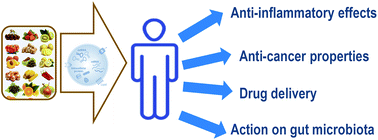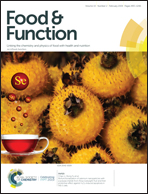Biological properties of plant-derived extracellular vesicles†
Abstract
Identification of active constituents of our diet is crucial to understand the impact of food on health, and disease development, and for the formulation of functional food and nutraceuticals. Until now research into the pharmacological properties of the components of our diet has focused on vitamins, sterols, polyphenols, fiber, etc. But very recently, it has been found that plants contain various types of vesicles which are in contact with the intestinal tract throughout our lives. They participate in intestinal tissue renewal processes and modulate gut microbiota in healthy subjects and have important biological functions against inflammatory diseases (e.g.; colitis injury, liver steatosis) or cancers associated with their specific lipid and miRNA content. In addition, recent data have suggested that plant-derived nanovesicles would be excellent candidates for the delivery of therapeutic agents (e.g.; anti-cancerous drugs, siRNAs) or poorly soluble natural compounds (e.g.; curcumin), as they are able to cross mammalian barriers without inducing either an inflammatory response or necrosis, conversely to conventional liposomes. It is thus important to consider these plant-derived vesicles as new components of our food in order to evaluate their potential for health benefit and food-derived technology.



 Please wait while we load your content...
Please wait while we load your content...